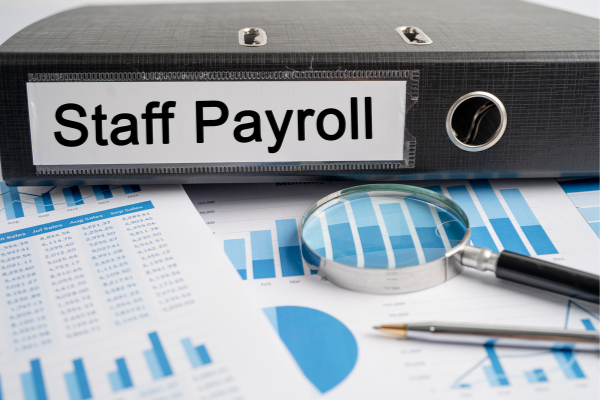Share
Payroll for charities can be a confusing subject, so if you are new to paying staff then here is the info you need to get you started.
All information included in this blog is accurate at the time of publishing 11 April 2022.
Payroll for charities - what you need to know
Payroll for charities can be really confusing, especially if you have never paid anyone before and with HMRC getting much hotter on rule-breaking it isn’t something you want to just guess about.
If you miss deadlines or make mistakes, there are penalties that are automatically applied and if HMRC thinks you have been careless they can charge you more.
So it is important to get to grips with payroll before you are ready to employ people, as there are some things you need to have in place in advance.
In this post, I am going to give you a quick overview of the things you need to know before you employ people. I’m going to look at;
- When to set up your payroll
- Should you use software?
- Running your payroll process
- Is it worth outsourcing?
- How do you pay self-employed and contractors?
- Get your payroll right
You don't have to register as an employer with HMRC if you are going to pay ALL of your employees below the Lower Earnings Limit (LEL), which is currently £120 per week but there are very few organisations that are in this position.
In reality, if you want to pay employees or construction contractors then you will need to register as an employer with HMRC.
It is important that you start the registration process with HMRC well before you take on any staff. You can register up to 2 months before you start paying people.
HMRC says that it takes 5 days for the registration process to be complete but I’d suggest doing it a bit before this because it can on occasion take quite a while and as we have seen through COVID there can sometimes be disruption to services.
The process is simple and you will be given an employer PAYE reference number and an accounts office number.
You can register as an employer here.

Should you use software?
This is an easy one to answer because you have no choice!
You have to submit your payroll returns to HMRC each time you run a payroll using the Real-Time Information (RTI) service from HMRC.
This means that you need to run your payroll using compatible software and then make the returns digitally before you pay people.
There are a lot of different offerings on the market. Some are very basic and cheap, some are complex and expensive but the majority obviously fall somewhere in between.
If you use an accounting system like Xero, Quickbooks or Sage you’ll find that they have very good and relatively cheap payroll additions that you can use for just a few pounds more each month.
The big benefit of this is that they will automatically put the pay information into your financial accounts as payroll is run.
Running your payroll process
Before you start employing people, you should think about and document your payroll process.
You need to have policies in place around overtime, sick pay, expenses etc. and you have to understand how you will manage things like collecting people’s hours. Remember also that before you employ someone you will need to check their right to work status.
Try to set out how you will pay people from end to end and it is worth setting this out in a document because it forces you to think about how you will do things.
You’ll also need to think about how you will pay people. In the early days, when you only have a few payments to make, you can do this quite easily from your online banking but as you grow you may want to look at other payment systems.
I would always suggest that you make up a payroll calendar at the start of each tax year where you can note down any important dates and deadlines. Remember that for payroll purposes your ‘year’ is from 6th April to 5th April the following year.
On your calendar, you’ll set out when you will close payroll to any further changes, when you will run the payroll and when you will make the payments. Remember to factor in bank holidays.
You can also add in payment dates for handing over tax and NICs to HMRC and making payments to pension providers and court services etc.
As part of the payroll process, you will need to make monthly returns from your software (called FPS) before you pay people and an Employer Payment Summary (EPS) if you have paid things like maternity/paternity pay or if you haven’t paid anyone at all.
You will also need to make an annual final return and this can be an FPS or EPS depending upon your software.

Is it worth outsourcing?
The answer as with so many things like this is that “it depends”!
Outsourcing your payroll has a lot of benefits.
Firstly, you don't need to worry about registering as an employer or completing your monthly and annual returns as they should be covered by your payroll company.
They will have software to carry out the work and to send in RTI returns and once the monthly payroll is done, they will send you the reports you need to update your accounts and make payments to your people and HMRC/pensions.
And possibly more importantly, they will have expertise on hand to deal with any issues you may have. The likelihood is that any problems you come up with, they will have dealt with before.
Your payroll outsource company should also be proactive in letting you know about deadlines such as your P11ds in advance.
A good outsourcing company should also be able to help you with questions about how you manage and structure your payroll and pay your people so that you don’t make mistakes that could end up costing you money.
But of course, it is probably going to cost more to outsource your payroll however, when you factor in the cost of your own software and paying someone to manage salaries, there is probably not a lot in it when you only have a few people.
Generally speaking, you are better off outsourcing where you have a small payroll but when that grows it becomes more economical to employ a specialist to do this, even if it is part-time.
Outsourcing the payroll also takes away the worry about who is going to cover payroll while your in-house staff are off sick or on holiday, or when the only person who understands payroll leaves the organisation!
There isn’t a hard and fast cut-off point unfortunately, it all comes down to your local conditions but as a rule of thumb, if you have less than 50 people on your books then outsourcing is probably the way to go, more than that and you may want to bring it in-house.
There are plenty of good payroll specialists out there that will do this for you or you can speak with your accountant who may have a package deal on offer.

How do you pay self-employed and contractors?
Please don’t make the mistake of thinking that paying people as though they were self-employed is a good way to get around the need to run a payroll. HMRC are wise to that particular trick!
There’s a simple rule of thumb I use to assess whether someone should be on the payroll and paid PAYE and this is what I call ‘the duck rule’.
If it walks like a duck and quacks like a duck then it is probably a duck.
So if someone works for you and they look and act like an employee then that’s a fair sign that they should be paid as an employee.
In most cases, this is a fairly easy thing to see. Contrast your window cleaner, who has his own business, many different clients and is registered as a self-employed person with someone who only ever works for you part-time and has no other jobs.
If you are unsure then take advice because HMRC has become very hot on disguised employment in the last couple of years.
Some contractors may have their own limited companies and so if you have more than 50 people working for you, then you’ll need to be aware of the requirements of IR35.
And if you regularly carry out construction type activities, then you may need to register for the Construction Industry Scheme (CIS).
Get your payroll right
Nothing destroys morale more than getting someone’s pay wrong or late.
Add to that the fact that if you make mistakes or miss deadlines, HMRC will levy penalties so you could end up costing your organisation money.
There are some things in life you can use a ‘suck it and see’ approach on but unfortunately, payroll isn’t one of them.
You have to get things in order right from the start and if you want to avoid getting in a terrible mess then you need to develop a methodical approach.
So make sure you take advice from people who are experienced in the job or speak with your accountants to see what they recommend.
Think about using an outsourcing company where this makes sense for you and talk to at least two or three to see if they are a good fit.
And if you are going it alone then invest in some proper payroll training so that you don’t end up making rookie errors!
Good luck with your payroll.

Our thanks to our volunteer Stuart Walker for sharing his knowledge and insight on payroll.
About the author
Stuart Walker MBA, ACMA, is a business writer specialising in SaaS, Fintech and Financial Services. Stuart is a Cranfield Trust volunteer based in the South West of England and uses his accountancy and finance expertise and skills to guide our charity clients with all aspects of financial control, planning and forecasting.




